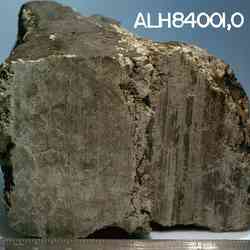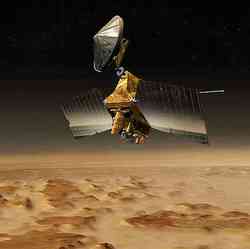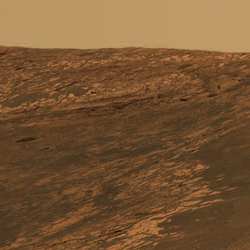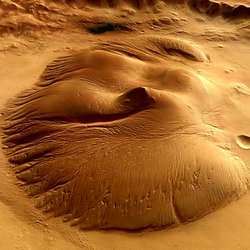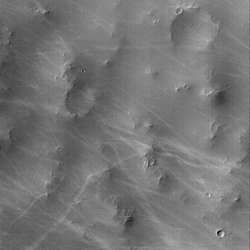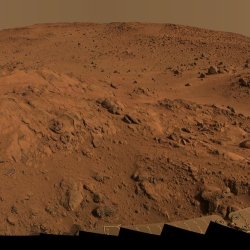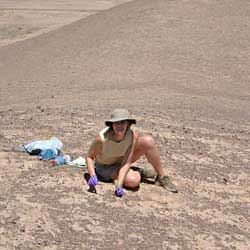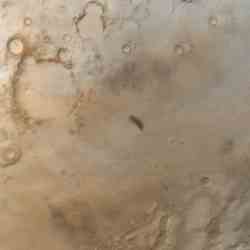
Frosted southern plains in early spring. Image credit: MSSS/JPL/ NASA Click to enlarge
The detections of methane in the martian atmosphere have challenged scientists to find a source for the gas, which is usually associated with life on Earth. One source that can be ruled out is ancient history: Methane can survive only 600 years in the martian atmosphere before sunlight will destroy it.
If the global concentration of methane on Mars is 10 ppb, then an average of 4 grams of methane is being destroyed every second by sunlight. That means about 126 metric tons of methane must be produced each year to ensure a steady concentration of 10 ppb.
There is an outside chance that the methane is being delivered to Mars by comets, asteroids, or other debris from space. Calculations show that micrometeorites are likely to deliver only 1 kilogram of methane a year — far short of the 126-ton replacement level. Comets could deliver a huge slug of methane, but the interval between major comet impacts averages 62 million years, so it’s unlikely that any comet delivered methane within the past 600 years.
If we can rule out methane delivery, then the methane must be manufactured on Mars. But is the source biology, or processes unassociated with life?
A small percentage of Earth’s methane is made through non-biological (“abiogenic”) interactions between carbon dioxide, hot water and certain rocks. Could this be occurring on Mars? Perhaps, says James Lyons of the Institute for Geophysics and Planetary Physics at UCLA.
These reactions require only rock, water, carbon and heat, but on Mars, where would the heat come from? The planet’s surface is stone cold, averaging minus 63 degrees C. Volcanoes could be a source of heat. Geologists think the most recent eruption on Mars was at least 1 million years ago — recent enough to suggest that Mars is still active, and therefore hot deep below the surface.
A trickle of methane averaging 4 grams per second could come from such a geological hot spot. But any martian hot spot must be deep and well-insulated from the surface, since the Thermal Emission Imaging System on Mars Odyssey found no locations that are at least 15 degrees C warmer than the surroundings. However, Lyons thinks it’s still possible that a deep body of magma could be supplying the heat.
In one computer model of simplified martian geology, a cooling body of magma 10 kilometers deep, 1 kilometer wide, and 10 kilometers long created the 375 to 450 degrees C temperature that drives abiogenic methane generation at mid-ocean ridges on Earth. Such a body of hot rock, Lyons says, “is perfectly sensible, there’s nothing strange about it,” because Mars probably retains some heat from planetary formation, much like Earth.
“It encourages us to think that this is a plausible scenario for explaining methane on Mars, and we would not see the signature of that dike (body of hot rock) on the surface,” says Lyons. “That’s the angle we are pursuing; it’s the simplest, most direct explanation for the methane detected.”
Although no one can rule out abiogenic sources for the methane on Mars, when you find methane on Earth, you are usually seeing the work of methanogens, ancient anaerobic microbes that process carbon and hydrogen into methane. Could methanogens live on Mars?
To find out, Timothy Kral, associate professor of biological sciences at the University of Arkansas, began growing five types of methanogens 12 years ago in volcanic soil chosen to simulate martian soil. He’s now shown that methanogens can survive for years on the granular, low-nutrient soil, although when grown in Mars-like conditions, at just 2 percent of Earth’s atmospheric pressure, they become desiccated and go dormant after a couple of weeks.
“The soil tends to dry out, and we have been able to find viable cells; they are still alive, but they don’t produce methane anymore,” Kral says.
Methanogens need a steady source of carbon dioxide and hydrogen. While carbon dioxide is abundant on Mars, “hydrogen is a question mark,” Kral says.
Vladimir Krasnopolsky, a research professor at Catholic University of America in Washington D.C., detected 15 parts per million of molecular hydrogen in the atmosphere of Mars. It is possible that this hydrogen is escaping from a deep source in the martian interior which methanogens could use.
If methanogens are deep inside Mars, the methane gas they produce would slowly rise toward the surface. Eventually it could reach a pressure-temperature condition where it would get trapped in ice crystals, forming methane hydrate.
“If there were a subsurface biosphere, methane hydrate would be an inevitable consequence, if things behave as they do on Earth,” says Stephen Clifford of the Lunar and Planetary Institute in Houston, Texas.
And there’s a fringe benefit, Clifford adds. Methane hydrates, “would be an insulating blanket that would substantially reduce the thickness of frozen ground on Mars, from several kilometers at the equator, to maybe less than a kilometer.” In other words, methane hydrate would both store evidence of life and insulate any life that remained from the ultra-cold surface temperatures.
Although data on conditions a kilometer or so below the martian surface are non-existent, the growing picture of the complexity, size and adaptability of Earth’s underground biosphere certainly improves the chance that life exists in comparable conditions inside Mars. Earth’s underground biosphere is composed largely of microbes, some of which live at depths, pressures and chemical conditions once thought inhospitable to life.
Deep inside Mars may be a hardscrabble place to make a living, but methanogens are no wimps, Kral says. “They are tough, durable. The fact that they have been around probably since the beginning of life on Earth, and continue to be the predominant life form below the surface and deep in the oceans, means they are survivors, they are doing extremely well.”
Original Source: NASA Astrobiology


